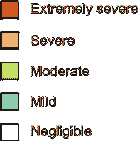
 |
The following map of the atmospheric corrosivity measured in Cuba was adapted from "Atmospheric Corrosion of Copper in Ibero-America" by M. Morcillo, E. Almeida, M. Marrocos, and B. Rosales, Corrosion, Vol. 57, No. 11, pages 967-980.


Air, Water, Ground: Air Pollution is serious. Cuba relies on trucks, buses and automobiles for transport which were built before 1959. They spew endless clouds of foul oily fumes which subvert respiratory tract of drivers, passengers and residents along Cuban streets and highways. As in the USA, Cuban government relies upon the tobacco industry for revenue. Cigars and Cigarette smoking contaminate the air in restaurants, hotels, homes and factories...when mixed with auto emissions and factory emissions, Cuban citizens imbibe a deadly cocktail of fumes.
Water pollution around farms, factories and large cities continues to challenge Cuban resources. Water supply in most places is safe to drink even if in short supply on occasion. One does not smell the odor of human sewage in Havana or other large cities as often is the case in other 3rd world countries...but basic equipment is old an in disrepair. Flush Toilets, wash bowls and shower stalls do not always work as North Americans come to expect.
Ground pollution is not a great problem in Cuba...the vast tonnage of toxic wastes found in industrial cities in Europe and the Americas is not yet a problem in Cuba. In Havana, countless tons of debris accumulate on the streets from construction, renovation and demolition. More an eyesore than a health hazard, such trash further deters from the beauty and charm of a world class city.
Other regions and countries: Argentina, Brazil, Canada, Central America, Chile, China, Colombia, Cuba, France, Germany, India, Italy, Japan, Mexico, New Zealand, North America, Portugal, Russia, Saudi Arabia, South Africa, Spain, Sweden, UK, USA, Venezuela
 |
 |